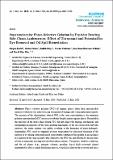Por favor, use este identificador para citar o enlazar a este item:
http://hdl.handle.net/10261/130257COMPARTIR / EXPORTAR:
 SHARE SHARE
 CORE
BASE CORE
BASE
|
|
| Visualizar otros formatos: MARC | Dublin Core | RDF | ORE | MODS | METS | DIDL | DATACITE | |

| Título: | Supramolecular phase-selective gelation by peptides bearing side-chain azobenzenes: Effect of ultrasound and potential for dye removal and oil spill remediation |
Autor: | Bachl, Jürgen CSIC; Oehm, Stefan; Mayr, Judith; Cativiela, Carlos CSIC ORCID; Marrero-Tellado, José Juan CSIC; Díaz Díaz, David CSIC ORCID | Palabras clave: | Azobenzene Peptide Dye removal Oil spill Phase-selective gelation Organogel Side-chain functionalization |
Fecha de publicación: | 22-may-2015 | Editor: | Multidisciplinary Digital Publishing Institute | Citación: | International Journal of Molecular Sciences 16(5): 11766-11784 (2015) | Resumen: | Phase selective gelation (PSG) of organic phases from their non-miscible mixtures with water was achieved using tetrapeptides bearing a side-chain azobenzene moiety. The presence of the chromophore allowed PSG at the same concentration as the minimum gelation concentration (MGC) necessary to obtain the gels in pure organic phases. Remarkably, the presence of the water phase during PSG did not impact the thermal, mechanical, and morphological properties of the corresponding organogels. In the case of miscible oil/water mixtures, the entire mixture was gelled, resulting in the formation of quasi-hydrogels. Importantly, PSG could be triggered at room temperature by ultrasound treatment of the mixture or by adding ultrasound-aided concentrated solution of the peptide in an oil-phase to a mixture of the same oil and water. Moreover, the PSG was not affected by the presence of salts or impurities existing in water from natural sources. The process could be scaled-up, and the oil phases (e.g., aromatic solvents, gasoline, diesel fuel) recovered almost quantitatively after a simple distillation process, which also allowed the recovery and reuse of the gelator. Finally, these peptidic gelators could be used to quantitatively remove toxic dyes from aqueous solutions. | Versión del editor: | http://dx.doi.org/10.3390/ijms160511766 | URI: | http://hdl.handle.net/10261/130257 | DOI: | 10.3390/ijms160511766 | ISSN: | 1661-6596 | E-ISSN: | 1422-0067 |
| Aparece en las colecciones: | (IQAC) Artículos (ISQCH) Artículos |
Ficheros en este ítem:
| Fichero | Descripción | Tamaño | Formato | |
|---|---|---|---|---|
| ijms-16-11766.pdf | 4,04 MB | Adobe PDF |  Visualizar/Abrir |
CORE Recommender
PubMed Central
Citations
7
checked on 19-abr-2024
SCOPUSTM
Citations
39
checked on 23-abr-2024
WEB OF SCIENCETM
Citations
33
checked on 26-feb-2024
Page view(s)
239
checked on 23-abr-2024
Download(s)
319
checked on 23-abr-2024

